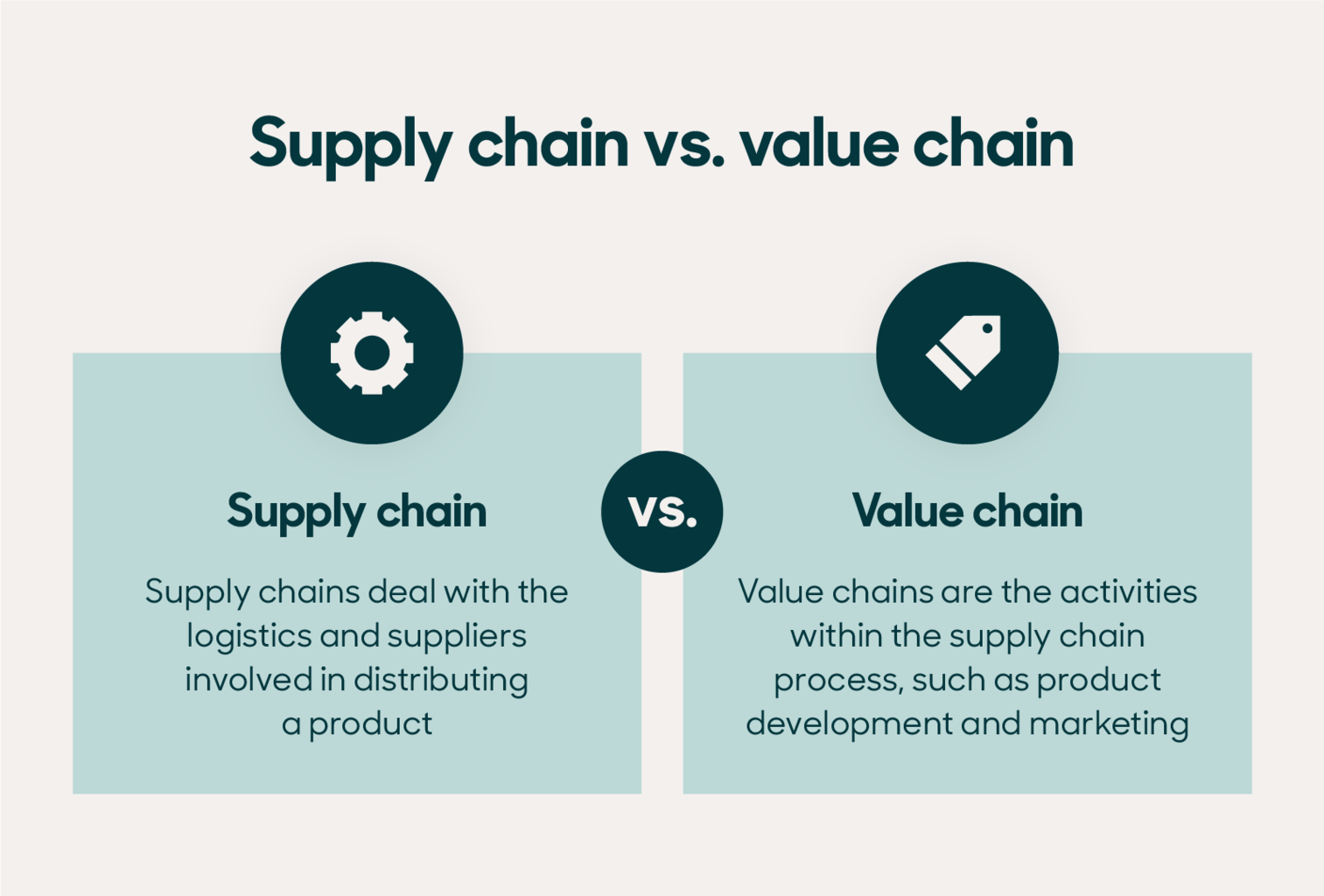Article • 9 min read
Value chain: definition, examples and guide
The value chain gives you the tools to maximise your company’s value and profit margin by evaluating all business activities.
By Donny Kelwig, Contributing Writer
Last updated June 7, 2023
Every executive in the world spends part of their day wondering how to make their products and services stand out while still turning a profit. That’s the dream of all businesses: create great products and earn a lot of revenue.
Though it’s easy to articulate, it’s not easy to accomplish. So, what separates the companies that rise to the top from those that crash and burn? Businesses succeed or fail for various reasons, but one of the most powerful reasons is their competitive edge.
A value chain is a model that helps companies determine their competitive advantage and refine their business practice to operate with maximum efficiency and the largest possible profit margins.
Keep reading to discover more about the value chain, value chain models and examples.
What is a value chain?
The value chain is a business model used to examine all company activities involved in taking a product or service from idea to sellable item.
Ideally, companies can use the value chain model to strengthen their point of view and widen their profit margin – more efficiency and fewer costs.
Generally speaking, there are two ways to improve the ‘value’ in your value chain:
- Increase the social value of your company and products via product quality and brand credibility so consumers will purchase more.
Decrease the costs of your product and production to encourage customers to purchase more and widen profit margins.
You can also use value chain analysis (VCA) to help boost profit by searching for improvements in specific activities within the sales and production lines.
By either increasing value or decreasing costs based on your company’s value chain, you create a competitive advantage in the market and hone your sales strategies.
Value chain benefits
The value chain framework enables your company to understand and analyse where cost efficiency is good or poor within the organisation. When you look at your company’s value chain analytically, you can:
Back up decisions regarding various business activities
Pinpoint areas of ineffectiveness and correct them
Understand the links and responsibilities between different aspects of your business
Optimise efficiency while lowering expenses
Create a cost advantage over competitors
See exactly where your business is succeeding
It might seem like a lot of work to review every single company activity to determine your competitive edge, but that insight makes a difference. Just as KPIs and reporting inform your sales operations and strategies, a comprehensive value chain analysis informs decisions across your entire business.
Supply chain vs. value chain

Although the supply chain and the value chain initially appear similar, there are some key differentiating factors.
With a supply chain, a business will deal with the logistics and suppliers that produce the product and then distribute it. A business value chain differs in that it’s the set of activities (such as product development, marketing and delivery) that occurs throughout the supply chain process.
In short, supply chains are more synonymous with operation management and customer satisfaction, while a value chain leans towards business management and competitive advantage.
Porter’s value chain: definition and components
The industry’s current understanding and model of the value chain comes from Michael Porter’s 1985 book, Competitive Advantage. Considering how quickly trends move in sales, the fact that we still use this model speaks to how well it works and how much it’s benefitted companies over the years.
Porter breaks value chain analysis (VCA) into five primary activities and four secondary activities that together create value greater than the cost of performing those activities individually.
That premise is as follows: you will create a profit when the overall cost of producing your product is less than the amount you sell that product for. However, many companies fail to diligently track every aspect of product creation and miss opportunities to increase profit margins.
Porter’s VCA components
The VCA chart is broken into two sections: primary activities and secondary (or support) activities. Primary activities focus on the manufacturing of goods and services, whilst secondary activities back up primary activities:
Primary activities
- Inbound logistics: Availability of raw materials, warehousing and distribution (essentially, anything in your supply chain)
- Operations: Creating products from raw materials
- Outbound logistics: Delivery of products to customers, including warehouse, transportation and distribution
- Marketing and sales: All advertising and sales interactions and activities
- Service: All forms of customer support interaction and brand credibility
Secondary activities
- Infrastructure: Any administrative, finance, management, planning or legal operations needed to support primary activities
- Technology development: Any technological improvements made to existing machinery, hardware or software in the name of supporting primary activities
- Human resource management: The process of hiring and managing workers
- Procurement: Purchases related to buying raw materials or any fixed assets (for example, vendor fees and selection)
Porter’s model showcases that the key to a successful value chain analysis is identifying which processes could be run more efficiently and implementing fixes in a timely fashion.
Value chain model: how to create one

If you’re looking to boost your company’s efficiency and add value to your products or services, consider creating a value chain model. Building a value chain model for your company is a repeated, four-step process:
Identify the sub-activities of each of your primary activities.
Identify the sub-activities of each of your secondary activities.
Find links between all activities.
Discover opportunities to increase value or decrease costs.
Like sales, your value chain is a cycle that you can evaluate at different points to ensure you’re achieving maximum velocity. Each step has meaning and opportunities for improvement. If you have sales on the brain, think of the value chain as your business pipeline.
1. Identify the sub-activities of each of your primary activities
According to Porter, there are three types of sub-activities possible for each of the five primary activities:
Direct activities
Indirect activities
Quality assurance
Direct activities
Direct activities are activities that create value on their own. For example, look at the primary activity of inbound logistics. A direct activity might be reaching out to suppliers for new raw materials.
Indirect activities
Indirect activities support direct activities and allow them to run smoothly. Looking again at the direct activity – reaching out to suppliers for new raw materials – the indirect activity to support it might be keeping an updated log of supplier contact information.
Quality assurance activities
Quality assurance activities ensure that both direct and indirect activities continually meet a certain quality standard. If we’re reaching out to secure suppliers and logging their contact information, a quality assurance activity might be researching the suppliers and making sure their company values align with yours.
For example, if you’re marketing yourself as an eco-friendly company, you’ll likely want to source your materials from other eco-friendly companies.
2. Identify the sub-activities of each of your secondary activities
Step two largely follows the parameters of step one. However, when you’re reviewing your secondary activities, you want to try and find sub-activities that also complement the primary activities.
Remember: the purpose of your secondary activities is to support the primary activities, so when you’re looking for sub-activities, they should do the same thing.
3. Find links between all activities
Company activities rarely occur in a vacuum. Most, if not all, of the actions your business takes impact other aspects of your business. The trick is to identify those links so that you can learn to take advantage of them.
For example, if you’re choosing a supplier, several factors can affect the process, so you need to ask yourself questions like:
Have you worked with them before?
What are they charging?
Where are they located?
Will transit outweigh product costs?
How fast can they deliver the raw materials?
Answering these questions will help you avoid going with the wrong supplier. For instance, you wouldn’t want to choose a supplier with a longer shipping or transit distance – that would negatively impact the rate of production, which influences the product price. That, in turn, affects the target audience, which impacts overall sales.
Similarly, if you’re working with an overall company budget and you choose to invest in higher-quality supplies, the money has to come out of the budget for another activity. It’s important to know which parts of your company create the most value so you can make an informed decision about where the money should come from.
4. Discover opportunities to increase value or decrease costs
Once you establish a comprehensive list of links and activities, try to find opportunities to increase value for the customer or decrease costs for the company. This is also the time to look for pockets of activity that aren’t adding significant value, such as outdated software you’re still paying for or old advertising you forgot to cancel.
You can also evaluate relationships and see which ones still benefit you. Not all business relationships are made to last, so use your business development team to cut ties with any loose threads.
Take advantage of our free value chain template
Ready to create a value chain analysis of your own? Is your business ready to identify areas for growth and uncover the activities that give your customers the most value? Use our template to help guide you.
Value chain example

Now, let’s take a look at an abridged value chain example for Apple and its primary activities:
Use a simple CRM to manage your value chain
Optimisation tips can be helpful, but the real secret to managing your value chain is a powerful CRM. While value chains are useful, they require analysing and tracking a massive amount of data across your entire company.
With efficient and simple CRM software, you can track data and communication automatically, which means you don’t have to compile or search for anything when it comes time to analyse your value chain.
Zendesk Sell combines on-demand data reports with impeccable communication so that nothing falls through the cracks. Thanks to a customisable and intuitively designed sales dashboard, your company can collect the data you need without wasting resources.
